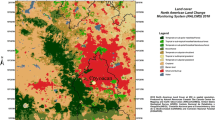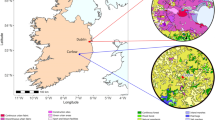Abstract
Aerobiological studies are still scarce in northwestern Mexico where allergenic pollen have great impacts on health. Current global pollution and climate change problems are closely related to many allergic diseases, enhancing the need to continue researching these issues and improve life quality. This study provides the first Pollen Calendar for Hermosillo, Sonora, México. Airborne pollen were continuously collected for 5 years (2015–2019). The standardized methodology with a Hirst-type spore trap proposed for global aerobiological studies was used. Weather data were also taken from a station located in the city and used to explore correlations between climate and airborne pollen concentrations in different seasons. The most important pollen taxa recorded in air belongs to herbaceous pollen, such as Poaceae, Ambrosia, Asteraceae, Chenopodiaceae-Amaranthaceae, and some shrub trees typical of this arid region, such as Nyctaginaceae, Prosopis, Parkinsonia, and Fabaceae. The most critical herbaceous pollen related to allergies have a long mean pollen season throughout the years, and the most critical periods with high pollen concentration in air occur in two seasons, spring (March–April) and summer–fall (August–October). In these 5 years, the correlation analyses for these two peaks indicate that a link exists between pollen in the air and decreases in precipitation and temperatures, and an increase in relative humidity. An inter-annual variability in pollen concentrations was recorded related to different weather conditions. Although pollen calendars are location-specific, they are useful for future research on biological air quality scenarios in different cities. Using this standardized method for other regions can provide pollen calendars that have been proven clinically important in allergic disease management worldwide.






Similar content being viewed by others
Data Availability
Data sets generated during the current study are available from the corresponding author on reasonable request. Airborne pollen counts from 2016-2019 are available at the Red Mexicana de Aerobiologia http://rema.atmosfera.unam.mx/rema/Default.aspx.
References
Allergen Encyclopedia (2021) Bougainvillea. Allergia & Autoinmune disease. Retrieved January 7, 2022 from https://www.thermofisher.com/diagnostic-education/hcp/mx/es/resource-center/allergen-encyclopedia/whole-allergens.html?key=k214)
Al-Nesf MA, Gharbi D, Mobayed HM, Dason BR, Mohammed Ali R, Taha S, Tuffaha A, Adeli M, Sattar HA, Trigo MdM (2020) The association between airborne pollen monitoring and sensitization in the hot desert climate. Clin Transl Allergy 10(35). https://doi.org/10.1186/s13601-020-00339-6
Anderegg WRL, Abatzoglou JT, Anderegg LDL, Zisca L (2021) Anthropogenic climate change is worsening North American pollen seasons. PNAS 118(7):e2013284118. https://doi.org/10.1073/pnas.2013284118
Andersen TB (1991) A model to predict the beginning of the pollen season. Grana 30:269–275
Arbes SJJ, Gernern PJ, Elliot L, Zeldin DC (2005) Prevalences of positive skin test responses to 10 common allergens in the US population: results from the third National Health and Nutrition Examination Survey. J Allergy Clin Immunol 116(2):377–383. https://doi.org/10.1016/j.jaci.2005.05.017
Ariano R, Canonica GW, Passalacqua G (2010) Possible role of climate changes in variations in pollen seasons and allergic sensitizations during 27 years. Ann Allergy Asthma Immunol 104(3):215–222. https://doi.org/10.1016/j.anai.2009.12.005
Batista-Roche LG, Huerta-Ocampo JA (2021) Mezquite: una planta alergénica de relevancia clínica en México. TIP Revista Especializada en Ciencias Químico-Biológicas 24:1–15. https://doi.org/10.22201/fesz.23958723e.2021.390
Buters JTM, Antunes C, Galveias A et al (2018) Pollen and spore monitoring in the world. Clin Transl Allergy 8(9). https://doi.org/10.1186/s13601-018-0197-8
Calderón-Ezquerro MC, Guerrero-Guerra C, Martínez-López B, Fuentes-Rojas F, Téllez-Unzueta F, López- Espinoza ED, Calderón-Segura ME, Martínez-Arroyo A, Trigo-Pérez MM (2015) The first airborne pollen calendar and its relationship with bioclimatic factors in Mexico City. Aerobiologia 32:225–244. https://doi.org/10.1007/s10453-015-9392-4
Calderon-Ezquerro MC, Guerrero-Guerra C, Galán C, Serrano-Silva N, Guidos-Fogelbach G, Jiménez-Martínez MC et al (2018) Pollen in the atmosphere of Mexico City and its impact on the health of the pediatric population. Atmos Environ 186:198–208
Camacho I, Caeiro E, Nunes C, Morais-Almeida M (2019) Airborne pollen calendar of Portugal: a 15-year survey (2002–2017). Allergol Immunopathol. https://doi.org/10.1016/j.aller.2019.06.012
Crimmins TM, Crimmins MA, David Bertelsen C (2010) Complex responses to climate drivers in onset of spring-flowering across a semi-arid elevation gradient. J Ecol 98(5):1042–1051. https://doi.org/10.1111/j.1365-2745.2010.01696.x
D’Amato G, Holgate ST, Pawankar R et al (2015) Meteorological conditions, climate change, new emerging factors, and asthma and related allergic disorders. A statement of the World Allergy Organization. World Allergy Organ J 8:1–52. https://doi.org/10.1186/s40413-015-0073-0
De Weger LA, Bergmann KC, Rantio-Lehtimäki A, Dahl A, Buters J, Déchamp C et al (2013) Impact of pollen. In: Sofiev M, Bergmann K-C (eds) Allergenic pollen: a review of the production, release, distribution and health impacts. Springer, Dordrecht, pp 161–215
Di Menno di Bucchianico A, Brighetti MA, Cattani G, Costa C, Cusano M, De Gironimo V, Froio F, Gaddi R, Pelosi S, Sfika I, Travaglini A, Tripodi S (2019) Combined effects of air pollution and allergens in the city of Rome. Urban For Urban Green 3713–23. https://doi.org/10.1016/j.ufug.2018.04.001
Galán C, Cariñanos P, Alcázar P, Domínguez-Vilches E (2007) Spanish Aerobiology Network (REA): management and quality manual. Publications Services of the University of Cordoba, España
Galán C, Ariatti M, Bonini M, Clot B, Crouzy B, Dahl A, Fernandez-Gonzalez D, Frenguelli G, Gehrig R, Isard I et al (2017) Recommended terminology for aerobiological studies. Aerobiologia 33:293–295
García E (2004) Modificación al sistema de clasificación climática de Koppen. Instituto de Geografía, UNAM, México
Garcia-Mozo H (2017) Poaceae pollen as the leading aeroal- lergen worldwide: a review. Allergy 72(12):1849–1858. https://doi.org/10.1111/all.13210
Ghiani A, Aina R, Asero R, Bellotto E, Citterio S (2012) Ragweed pollen collected along high-traffic roads shows a higher allergenicity than pollen sampled in vegetated areas. Allergy. https://doi.org/10.1111/j.1398-9995.2012.02846.x
Grewling L, Bogawski P, Kryza M, Magyar D, Sikoparija B, Skjoth CA et al (2019) Concomitant occurrence of anthropogenic air pollutants, mineral dust and fungal spores during long-distance transport of ragweed pollen. Environ Pollut 254:112948. https://doi.org/10.1016/j.envpol.2019.07.116
Hirst JM (1952) An automatic volumetric spore trap. Ann Appl Biol 39:257–265. https://doi.org/10.1111/aab.952.39.issue-2
Instituto Nacional de Estadística, Geografía e Informática (INEGI) (2020) Carta de uso de suelo y vegetación. Retrieved from https://www.inegi.org.mx/temas/usosuelo/. Accessed Febrier 2022
Instituto Nacional de Estadística, Geografía e Informática (INEGI) (2021) Aspectos Geográficos Sonora. Retrieved from https://www.inegi.org.mx/contenidos/app/areasgeograficas/resumen/resumen_26.pdf. Accessed Mars 2022
Katotomichelakis M, Nikolaidis C, Makris M, Zhang N, Aggelides X, Constantinidis TC et al (2015) The clinical significance of the pollen calendar of the Western Thrace/northeast Greece region in allergic rhinitis. Inter- Natl Forum Allergy Rhinol 5(12):1156–1163. https://doi.org/10.1002/alr.21623
Kim KH, Jahan SA, Kabir E (2013) A review on human health perspective of air pollution with respect to allergies and asthma. Environ Int 59:41–52. https://doi.org/10.1016/j.envint.2013.05.007
Larenas-Linnemann D, Michels A, Dinger H, Shah-Hosseini K, Mösges et al (2014) Allergen sensitization linked to climate and age, not to intermittent-persistent rhinitis in a cross-sectional cohort study in the (sub) tropics. Clin Transl Allergy 4(20). https://doi.org/10.1186/2045-7022-4-20
Lo F, Bitz CM, Battisti DS, Hess JJ (2019) Pollen calendars and maps of allergenic pollen in North America. Aerobiologia 35(4):613–633. https://doi.org/10.1007/s10453-019-09601-2
López-Romero C, Huerta-Romero J, Frías-Mendivil M (2017) Sensibilización a alérgenos en pacientes pediátricos mayores de 2 años en el Hospital Infantil del Estado de Sonora. Boletin Clinica Hospital Infantil Del Estado De Sonora 34(2):90–96
Martínez-Bracero M, Alcázar P, Díaz de la Guardia C, González-Minero FJ, Ruiz L, Trigo Pérez MM et al (2015) Pollen calendars: a guide to common airborne pollen in Andalusia. Aerobiologia 31:549–557
Molina-Freaner FE, Van-Devender TR (2000) Diversidad biológica de Sonora. CONABIO-UNAM, Mexico City
Motta AC, Marliere M, Peltre G, Sterenberg PA, Lacroix G (2006) Traffic-related air pollutants induce the release of allergen-containing cytoplasmic granules from grass pollen. Int Arch Allergy Immunol 139(4):294–298. https://doi.org/10.1159/000091600
Myszkowska D (2020) Aerobiological studies–current state and future challenges. Alergoprofil 16(1):8–14. https://doi.org/10.24292/01.AP.161300320
Ortega-Rosas CI, Calderón-Ezquerro MC (2019) Gutiérrez-Ruacho OG (2019) Fungal spores and pollen are correlated with meteorological variables: effects in human health at Hermosillo Sonora Mexico. Int J Environ Health Res. https://doi.org/10.1080/09603123.2019.1625031
Ortega Rosas CI, Martínez Salido J, Sánchez Duarte NE, Morales Romero D (2022) Cobertura y composición arbórea en las áreas verdes de Hermosillo, Sonora: aportaciones al urbanismo sustentable. Región y sociedad 34:e1610. https://doi.org/10.22198/rys2022/34/1610
Ortega-Rosas CI, Meza-Figueroa D, Vidal-Solano JR, González-Grijalva B, Schiavo B (2021) Association of airborne particulate matter with pollen, fungal spores, and allergic symptoms in an arid urbanized area. Environ Geochem Health 43:1761–1782. https://doi.org/10.1007/s10653-020-00752-7
Pawankar R, Canonica GW, Holgate ST, Lockey RF, Blaiss MS (2011) WAO white book on allergy. Milwaukee, WI: World Allergy Org 3:156–157
Prevéy JS (2020) Climate Change: flowering may be shifting in surprising ways. Curr Biol 30:R112–R133
Rahman A, Luoa C, Rahaman Khana MH, Ked J, Thilakanayaka V, Kumar S (2019) Influence of atmospheric PM2.5, PM10, O3, CO, NO2, SO2, and meteorological factors on the concentration of airborne pollen in Guangzhou, China. Atmos Environ 212:290–304. https://doi.org/10.1016/j.atmosenv.2019.05.049
Rapiejko P, Stanlaewicz W, Szczygielski K, Jurkiewicz D (2007) Threshold pollen count necessary to evoke allergic symptoms. Otolaryngologia Polsk = Polish Otolaryngol 61(4):591–594. https://doi.org/10.1016/S0030-6657(07)70491-2
Rodríguez-de la Cruz D, Sánchez-Reyes E, Dávila-González I, Lorente-Toledano F, Sánchez-Sánchez J (2015) Airborne pollen calendar of Salamanca, Spain, 2000–2007. Allergol Immunopathol 38(6):307–312
Rodríguez-Solà R, Casas-Castillo MC, Zhang JJH, Kirchner R, Alarcón M, Periago C, De Linares C, Belmonte J (2022) A study on correlations between precipitation ETCCDI and airborne pollen/fungal spore parameters in the NE Iberian Peninsula. Int J Biometeorol 66(6):1173–1187. https://doi.org/10.1007/s00484-022-02267-5
Rosas-Alvarado A, Bautista-Huerta M, Velázquez- Sámano G (2011) Atlas de los pólenes alergénicos de mayor relevancia en México. Rev Alerg Mex 58(3):162–170
Schramm PJ, Brown CL, Saha S, Conlon KC, Manangan AP, Bell JE, Hess JJ (2021) A systematic review of the effects of temperature and precipitation on pollen concentrations and season timing, and implications for human health. Int J Biometeorol 65(10):1615–1628. https://doi.org/10.1007/s00484-021-02128-7
Sénéchal S, Visez N, Charpin D, Shahali Y, Peltre G, Biolley JP, Lhuissier F, Couderc R, Yamada O, Malrat-Domenge A, Pham-Thi N, Poncet P, Sutra JP (2015) A Review of the Effects of Major Atmospheric Pollutants on Pollen Grains, Pollen Content, and Allergenicity. Sci World J. https://doi.org/10.1155/2015/940243
Sofiev M, Bergmann K (2013) Allergenic pollen: a review of the production, release, distribution and health impacts. Springer, Netherlands
Spieksma FThM, Wahl PG (1991) Allergenic significance of Artemisia (Mugwort) pollen. In: D’Amato G, Th F, Spieksma M, Bonini S (eds) Allergenic pollen and pollinosis in Europe. Blackwell Scientific Publications, Oxford
Stix E, Ferretti ML (1974) Pollen calendars of three locations in Western Germany. In: Surinyach R, Frankland AW (eds) Charpin J. Atlas European des pollens allergisant, Paris, Sandoz
Van Devender T, Reina-Guerrero AL (2021) The vegetation of Sonora, Mexico. Phytoneuron 67:1–22
van Vliet AJH, Overeem A, Groot RSD, Jacobs AFG, Spieksma FTM (2002) The influence of temperature and climate change on the timing of pollen release in the Netherlands. Int J Climatol 22(14):1757–1767. https://doi.org/10.1002/joc
Zachmann LJ, Wiens JF, Franklin K, Crausbay SD, Landau VA, Munson SM (2021) Dominant Sonoran Desert plant species have divergent phenological responses to climate change. Madroño 68(4):473–486
Zhang Y, Bielory L, Mi Z, Cai T, Robock A, Georgopoulos P (2014) Allergenic pollen season variations in the past two decades under changing climate in the United States. Glob Change Biol 21(4):1581–1589. https://doi.org/10.1111/gcb.12755
Acknowledgements
This research was financially supported by Consejo Nacional de Ciencia y Tecnología-(CONACyT, in English, National Council of Science and Technology) in Mexico and to Secretaria de Medio Ambiente y Recursos Naturales (SEMARNAT, in English, Ministry for the Environment and Natural Resources) in Mexico through Grant Number 263413 to Professor Ortega-Rosas. The authors thank Carlos Enciso for illustration assistance in Fig. 1, and Diana Fischer and Michael Thomas Bogan for the English edition.
Author information
Authors and Affiliations
Corresponding author
Supplementary Information
Below is the link to the electronic supplementary material.
Rights and permissions
Springer Nature or its licensor (e.g. a society or other partner) holds exclusive rights to this article under a publishing agreement with the author(s) or other rightsholder(s); author self-archiving of the accepted manuscript version of this article is solely governed by the terms of such publishing agreement and applicable law.
About this article
Cite this article
Ortega-Rosas, C.I., Gutiérrez-Ruacho, O.G., Brito-Castillo, L. et al. Five-year airborne pollen calendar for a Sonoran Desert city and the relationships with meteorological variability. Int J Biometeorol 67, 1853–1868 (2023). https://doi.org/10.1007/s00484-023-02546-9
Received:
Revised:
Accepted:
Published:
Issue Date:
DOI: https://doi.org/10.1007/s00484-023-02546-9




